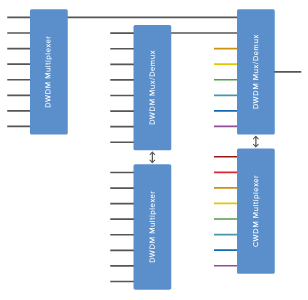THE POWER OF PASSIVE: OPTICAL NETWORKING
“Passive.” It can sound negative. Powerless. But when it refers to optical CWDM and DWDM optical networking it’s anything but. Passive indicates there are no powered parts inside. As opposed to an active system that has a powered element like a power supply unit, plug in transponder card or network management board.
Passive optical networking the Smartoptics way
The need to transmit data grows with every new department, new service, new communication application, new security requirement. Increases that can buckle existing systems. That’s one reason companies seek to upgrade their fiber networks. Laying new fiber optic cable can be prohibitively expensive. And so is adding “one off” services through leased or managed services. Expanding network capacity with Smartoptics is easy with plug and play solutions that are far less costly to own and run.
A passive xWDM network, also known as an embedded xWDM, works on the same principle of sending multiple data signals over a single dark fiber network on different wavelength channels. But with a difference to active (transponder based) xWDM: The xWDM transceiver is connected directly to the FC or Ethernet switch. This output signal is then connected directly to the multiplexer. With a transponder, an OEO conversion process takes a grey (uncolored or non-xWDM) signal from the FC or Ethernet switch and converts it to xWDM. An OEO process also introduces unwanted latency.
The advantage: the capacity of the system for network connectivity applications like data backhauling, SAN backup and replication, Ethernet connectivity, etc. Passive systems have the same wavelength channel capacity as active systems. For CWDM 18 channels of SAN &/or WAN are possible with SAN at 16Gbps and WAN at 10Gbps. If a system starts with CWDM it can be upgraded with an additional 26 DWDM channels by using the 1530 and 1550nm CWDM channels (16 in the 1550nm window and a further 10 in the 1530nm window). This hybrid CWDM/DWDM system is an effective way of preserving the investment in early CWDM deployments without any forklift replacements for higher capacity requirements. And a passive DWDM network offers up to 80 channels, and with tunable 100G DWDM transceivers able to transmit over 50GHz wavelength channels, the capacity of such a system is up to two terabytes – all from a passive (in this case) 2U architecture.
-
Keep channels 1530 and 1550nm open from day one. Concept scales for future network expansion.
- T-3009 CWDM Mux/Demux for eight channels
- T-3016 CWDM expansion multiplexer from eight to 16 CWDM channels
- T-3809 DWDM expansion multiplexer for additional 8+8 DWDM channels in 1550nm window
- T-3808 DWDM expansion multiplexer for additional eight DWDM channels in 1550nm window
- T-3810 DWDM expansion multiplexer for additional ten DWDM channels in 1530nm window
| Network type | Capacity | Traffic types | Data types |
| Passive CWDM | 18 channels | 4/8/16G FC and/or 1/10G WAN | 288G SAN / 180G WAN. |
| Passive hybrid | 42 channels | 4/8/16G FC and/or 1/10/100G WAN | 672G SAN / 420G WAN. |
| Passive DWDM | 80 channels | 4/8/16G FC and/or 1/10/100G WAN | 1.28T SAN / 2T WAN. |
Passive optical networking for all needs
Passive networking. The cost is a fraction of an active system and frees up initial investment and maintenance that can be spent in other areas of the network. With an embedded xWDM system there is no noise, fans, emissions, resulting in a green data center network. Networking as it should be – simple and cost effective.

Learn about our full range of passive Multiplexers and OADMs
Download the free product selection guide
Related articles

Why hundreds of enterprises with mission-critical workloads choose Smartoptics for Brocade networking

Four reasons to choose Smartoptics for Brocade SAN DCI

